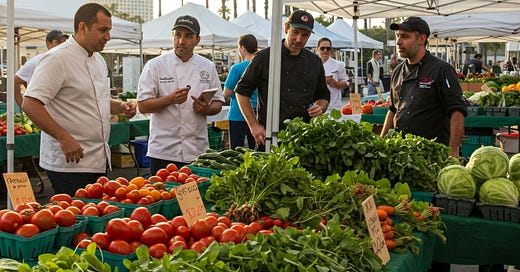On a cool Wednesday morning in Los Angeles, before most of the city’s espresso machines start humming, you’ll find top chefs weaving through crowded stalls under white tents at the Santa Monica Farmers Market. Clipboard in hand, sunglasses resting on their heads, they speak the language of heirloom tomatoes, wild arugula, and dry-farmed strawberries. This isn’t just a farmers’ market. It’s the kitchen of LA’s dining scene — a place where menus begin, relationships are forged, and ingredients are revered.
But it didn’t start out that way.
Humble Origins in a Changing City
The Santa Monica Farmers Market opened in 1981, during a time when LA's food scene was still catching up to the East Coast in terms of culinary reputation. Back then, the market was just a modest municipal initiative, part of a growing movement in California to support local agriculture and make fresh produce accessible. Farmers brought citrus, lettuce, stone fruit, and squash from the Central Valley or nearby Ventura County — not for acclaim, but for livelihood.
At first, it was locals who flocked here: retirees with tote bags, health-conscious yogis, and young moms pushing strollers. It was functional, not fashionable. But two things changed that trajectory: California cuisine and a new breed of chefs.
The Rise of the Chef-Driven Market
Enter the 1990s and early 2000s. California cuisine — with its emphasis on local, seasonal, and fresh ingredients — was booming, thanks to culinary pioneers like Alice Waters in Berkeley and, closer to LA, chefs like Nancy Silverton and Suzanne Goin. The philosophy wasn’t just about what to cook; it was about where it came from.
These chefs didn’t want anonymous produce trucked in from across the country. They wanted to know their growers, ask questions about soil and varietals, and get first pick of what was coming off the truck. The Santa Monica market offered all of that, and more.
Soon, chefs weren’t just visiting — they were planning their entire menus around what they found there that morning. The market shifted. The relationship between farmer and chef became symbiotic, and the produce became curated. Growers started tailoring crops for specific restaurants: tiny, sweet turnips for Gjelina, or exotic microgreens for Providence.
Santa Monica as Culinary Epicenter
By the 2010s, the Santa Monica Farmers Market had become a backstage pass to LA’s fine dining industry. Early morning became a who’s who of culinary elites: Michael Cimarusti, Josiah Citrin, Travis Lett — all prowling the same stalls, chatting with farmers, inspecting produce like jewels. The chefs weren’t just customers; they were collaborators.
The farmers adjusted their crops to serve chefs' evolving demands. Rare Japanese eggplant, black garlic, or limited-season figs would be pre-ordered or even grown exclusively for specific restaurants. Young cooks were sent by mentors to “do the market run” — a rite of passage and a lesson in the value of sourcing. Some even fell in love with the farmers they met.
This model — a dynamic, chef-centric market that was both high-volume and deeply personal — turned Santa Monica into more than a marketplace. It became the supply chain backbone of the city’s best kitchens.
Beyond the Plate
Today, the market still serves the neighborhood — you’ll see regulars carting away greens and fresh bread — but its influence is national. Food writers, influencers, and tourists treat it as a pilgrimage site. What appears on the table at Pizzana or Mélisse likely passed through these stalls only hours before.
Beyond economics or logistics, the market fosters trust. Chefs know the names of the people growing their food. Farmers receive real-time feedback from some of the most discerning palates in the country. And diners, even if they don’t know it, taste that relationship every time they bite into a dish that began with a sunrise trip to Santa Monica.
The Kitchen Stays Open
The story of Santa Monica’s farmers market isn’t just about beautiful produce or famous chefs. It’s about what happens when a city treats food not just as fuel, but as culture. It’s about creating a system where growers and cooks aren’t at opposite ends of a supply chain, but working side by side.
And in a world of ghost kitchens and global supply chains, this patch of asphalt by the Pacific remains rooted in something refreshingly simple — a chef, a farmer, and whatever nature offers that week.
Join us: ➡️ Instagram | Telegram | X ⬅️




